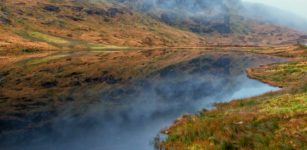Odd Monster Namazu ‘Earth Shaker’ Was First Feared By People And Later Worshiped As Luminous Deity Repairing The World
A. Sutherland - AncientPages.com - In ancient times, people did not know the causes of earthquakes and other hazards. Therefore, the gods were most often responsible according to the people's beliefs.
Namazu-e (catfish picture). The deity Ebisu falls asleep while guarding the foundation stone (kaname ishi) for Kashima, allowing the Namazu to cause the quake that destroys Edo. Kashima (aka Takemikazuchi, enshrined at Kashima shrine) is seen returning on horseback, too late. The thunder deity is seen engaging in 'thunder farting'. Coins are seen falling from the destruction, indicating redistribution of wealth. Image credit: Unknown author - (International Research Center for Japanese Studies) - Public Domain
The ancient Egyptians lived in pre-scientific times, as did other ancient civilizations and cultures worldwide. The ancient Egyptian farmers did not know that seasonal rains caused the Nile waters to rise yearly. They thought the Nile flooded on orders from the gods, especially, Hapi.
If the gods were angry, they could punish people with a drought, and their crops would die, but too much flooding was dangerous and devastating for agriculture.
And who was 'responsible' for causing earthquakes according to Greek myths? Since the Greeks have always been forced to live with the awareness of seismic hazards, earthquakes have been inscribed in the myths they created. In myths, one can find the first attempts to explain the nature of seismic phenomena.
In Greek myths, Zeus and Poseidon were responsible for sending earthquakes. And let's not forget the giant Enceladus, trapped under Mount Etna in Sicily, usually blamed for earthquakes and volcanic eruptions. With every strong shock, Enceladus's name is still often invoked in expressions like "Enceladus is angry" or "The giant Enceladus has woken up."
All mythical giants were personifications of the forces of nature, and earthquakes are an example of such tremendous power against which man is powerless.
Namazu-e - Kashima controls Namazu with his sword. Image credit: Unknown author - (International Research Center for Japanese Studies) - Public Domain
Through the ages, Japan has often been haunted by devastating earthquakes that have shaped the country's history and culture.
Namazu (the 'Earthshaker)' represents a very odd monster in Japanese mythology. In folk beliefs, the gigantic catfish dwells deep in the water in the earth's center or occupy large caverns deep underground. The monster Namazu belongs to Kashima, the god of thunder, often mentioned as Takemikazuchi in myths.
He is the one who tries to tame the creature or at least restrain its unbelievable strength by putting a sacred kaname-ishi ('pinning rock') on Namazu's body. If the god Kashima is absent from time to time or relaxes his mind, a major earthquake will occur.
The ground would shake because Takemikazuchi–Kashima lost control over the creature and its craziness. In earlier beliefs of the poor Japanese, the giant Namazu wanted to punish the rich who had acquired their treasures by dishonesty.
In ancient times, myths and legends made gods and monsters responsible for harm caused to people. Today, science helps to explain various phenomena like earthquakes, floods, and more.
Abnormal behavior of various animals, such as dogs, crows, and fish, has been reported in various countries around the world. In Japan, "if a giant catfish in the ground gets angry, the ground
will shake," and the relationship between catfish and earthquakes
has been related since ancient times. It took, however, a long time to explain it scientifically.
Namazu-e - Daikoku redistributes wealthies's riches. The mallet-shaking god is probably Daikokuten; the catfish rider is presumably Takemikazuchi. Source - Public Domain
Now, it is confirmed that catfish are very sensitive to electricity. About a week before the M5.9 earthquake occurred in Tokyo Bay on February 2, 1992, an increase in the number of pulses of electromagnetic waves and the activity of catfish was carefully observed. It is suspected that it is related to the earthquake.
After the earthquake near Edo (present-day Tokyo) in 1855, the Japanese changed their attitude toward the creature and saw something positive in the Namazu's doings. According to the beliefs of many, the earthquakes that the monster created destroyed not only the cities but also living conditions and so, in this way, equalized the poor with the rich.
The Japanese began to worship him as a "great luminous deity repairing the world." With time, the popularity of the Namazu spread quickly among the Japanese. Kashima shrine began to offer a wide selection of earthquake talismans associated with Namazu to guard the body against earthquakes or as a magic to dispel anxiety.
Let's hope that it helps the Japanese Islands' residents develop a more positive attitude toward earthquakes that haunt the country.
Earthquakes have enormous power, and unfortunately, no successful fighting methods are available against them.
Written by – A. Sutherland AncientPages.com Senior Staff Writer
Copyright © AncientPages.com All rights reserved. This material may not be published, broadcast, rewritten or redistributed in whole or part without the express written permission of AncientPages.com
More From Ancient Pages
-
 Scipio Africanus – Rome’s Greatest General Who Defeated Unbeatable Hannibal
Featured Stories | Aug 5, 2021
Scipio Africanus – Rome’s Greatest General Who Defeated Unbeatable Hannibal
Featured Stories | Aug 5, 2021 -
 Roman Sexuality Was Far More Complex Than Simply Gay Or Straight – Pompeii’s House Of The Vettii Reveals Why
Featured Stories | Jan 24, 2023
Roman Sexuality Was Far More Complex Than Simply Gay Or Straight – Pompeii’s House Of The Vettii Reveals Why
Featured Stories | Jan 24, 2023 -
 Guide To The Classics: On The Art Of Physical Exercise, A 16th Century Account Of Ancient Sports And Workouts
Featured Stories | Jul 26, 2024
Guide To The Classics: On The Art Of Physical Exercise, A 16th Century Account Of Ancient Sports And Workouts
Featured Stories | Jul 26, 2024 -
 Florida’s Windover Bog Bodies Predate The Egyptian Pyramids And Can Rewrite Ancient American History
Featured Stories | Jun 3, 2021
Florida’s Windover Bog Bodies Predate The Egyptian Pyramids And Can Rewrite Ancient American History
Featured Stories | Jun 3, 2021 -
 Assyrian King Ashurbanipal’s Great Library With Thousands Of Cuneiform Tablets
Civilizations | Dec 9, 2015
Assyrian King Ashurbanipal’s Great Library With Thousands Of Cuneiform Tablets
Civilizations | Dec 9, 2015 -
 Legendary Epic Of King Gesar Who Descended From Heaven And The Ancient Tarna Monastery
Featured Stories | Nov 20, 2021
Legendary Epic Of King Gesar Who Descended From Heaven And The Ancient Tarna Monastery
Featured Stories | Nov 20, 2021 -
 Mythical Temple Of Wingded Warrior God Haldi In The ‘City Of The Raven’
Civilizations | Jul 21, 2016
Mythical Temple Of Wingded Warrior God Haldi In The ‘City Of The Raven’
Civilizations | Jul 21, 2016 -
 Unique Wooden Stave Churches Were Built Without Nails – Remarkable Technology Helped Them Survive
Featured Stories | Nov 15, 2022
Unique Wooden Stave Churches Were Built Without Nails – Remarkable Technology Helped Them Survive
Featured Stories | Nov 15, 2022 -
 Skidi Pawnee Indians – One Of The Best Sky Watchers Of Ancient Times And Their Star Chart
Civilizations | Jul 5, 2014
Skidi Pawnee Indians – One Of The Best Sky Watchers Of Ancient Times And Their Star Chart
Civilizations | Jul 5, 2014 -
 Mysterious Denny – 90,000-Year-Old Child Whose Parents Were Two Different Human Species
Featured Stories | Jul 25, 2023
Mysterious Denny – 90,000-Year-Old Child Whose Parents Were Two Different Human Species
Featured Stories | Jul 25, 2023 -
 Ancient Mystery Of The Before – Time People – Traces Of An Unknown Lost Race – Part 1
Civilizations | Apr 3, 2019
Ancient Mystery Of The Before – Time People – Traces Of An Unknown Lost Race – Part 1
Civilizations | Apr 3, 2019 -
 Peculiar Accounts Of Ancient Flying Metallic Dragons And Bells In China And Japan
Chinese Mythology | Dec 27, 2018
Peculiar Accounts Of Ancient Flying Metallic Dragons And Bells In China And Japan
Chinese Mythology | Dec 27, 2018 -
 Legend Of Brigadoon: Mythical Village Where Time Stands Still
Featured Stories | Nov 2, 2016
Legend Of Brigadoon: Mythical Village Where Time Stands Still
Featured Stories | Nov 2, 2016 -
 Arsinoe II Rose To Power Through Manipulations, Murder, Conspiracies And Became Worshiped As A Goddess
Featured Stories | Apr 26, 2019
Arsinoe II Rose To Power Through Manipulations, Murder, Conspiracies And Became Worshiped As A Goddess
Featured Stories | Apr 26, 2019 -
 Butterfly: Powerful Ancient Symbol Of Beauty, Transformation, Hope, Rebirth And Happiness Featured In Myths And Legends
Ancient Symbols | Sep 26, 2019
Butterfly: Powerful Ancient Symbol Of Beauty, Transformation, Hope, Rebirth And Happiness Featured In Myths And Legends
Ancient Symbols | Sep 26, 2019 -
 Ankhesenamun – Mysterious Death Of Tutankhamun’s Wife Ended The True Amarna Bloodline
Featured Stories | Mar 23, 2018
Ankhesenamun – Mysterious Death Of Tutankhamun’s Wife Ended The True Amarna Bloodline
Featured Stories | Mar 23, 2018 -
 Ashurbanipal – Last Great Ruler Of Assyria And His Famous Well-Organized Library
Featured Stories | Jun 21, 2021
Ashurbanipal – Last Great Ruler Of Assyria And His Famous Well-Organized Library
Featured Stories | Jun 21, 2021 -
 Emperor Kublai Khan: One Of The Most Powerful People In Human History
Featured Stories | May 23, 2017
Emperor Kublai Khan: One Of The Most Powerful People In Human History
Featured Stories | May 23, 2017 -
 Ancient Monuments The World Is Not Allowed To See – Forbidden Zone – Part 2
Featured Stories | Aug 27, 2020
Ancient Monuments The World Is Not Allowed To See – Forbidden Zone – Part 2
Featured Stories | Aug 27, 2020 -
 Hidden Details In Ancient Egyptian Tomb Paintings Revealed By Chemical Imaging
Featured Stories | Jul 28, 2023
Hidden Details In Ancient Egyptian Tomb Paintings Revealed By Chemical Imaging
Featured Stories | Jul 28, 2023



